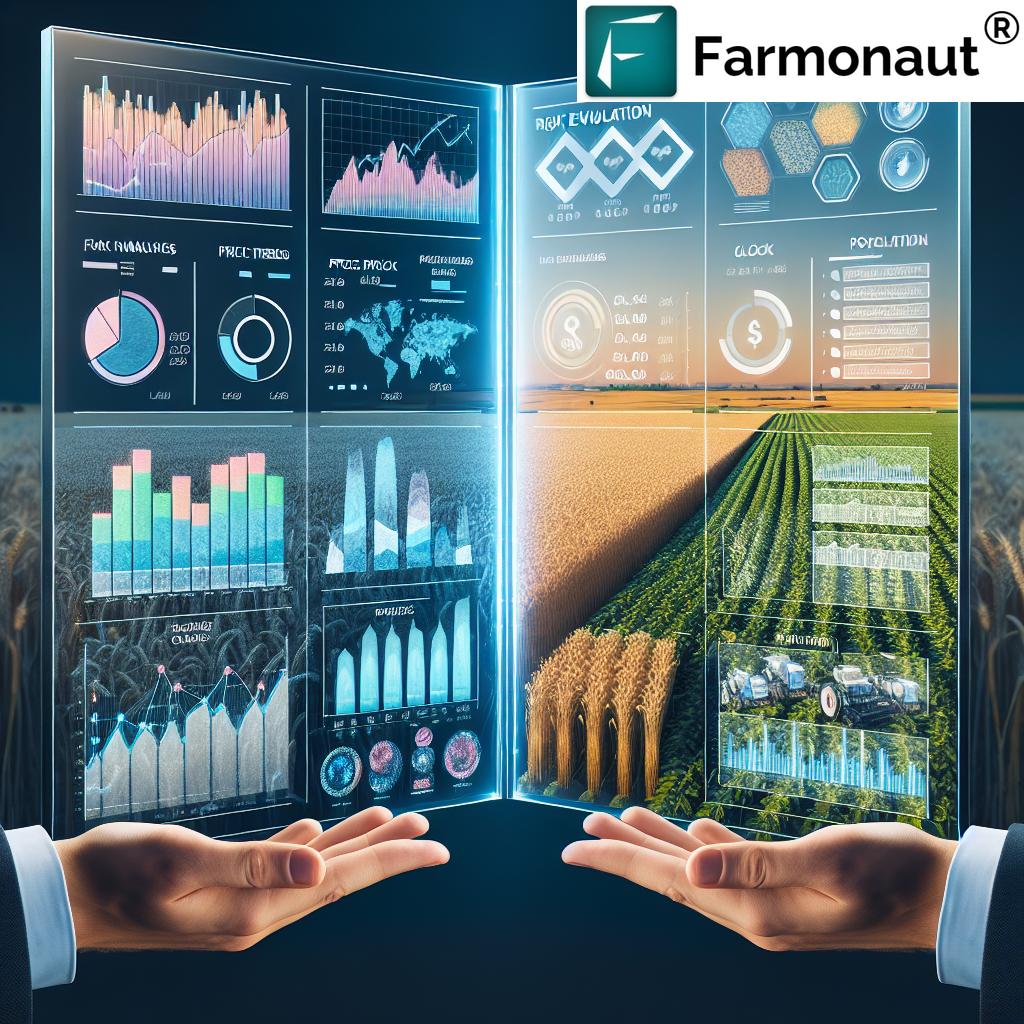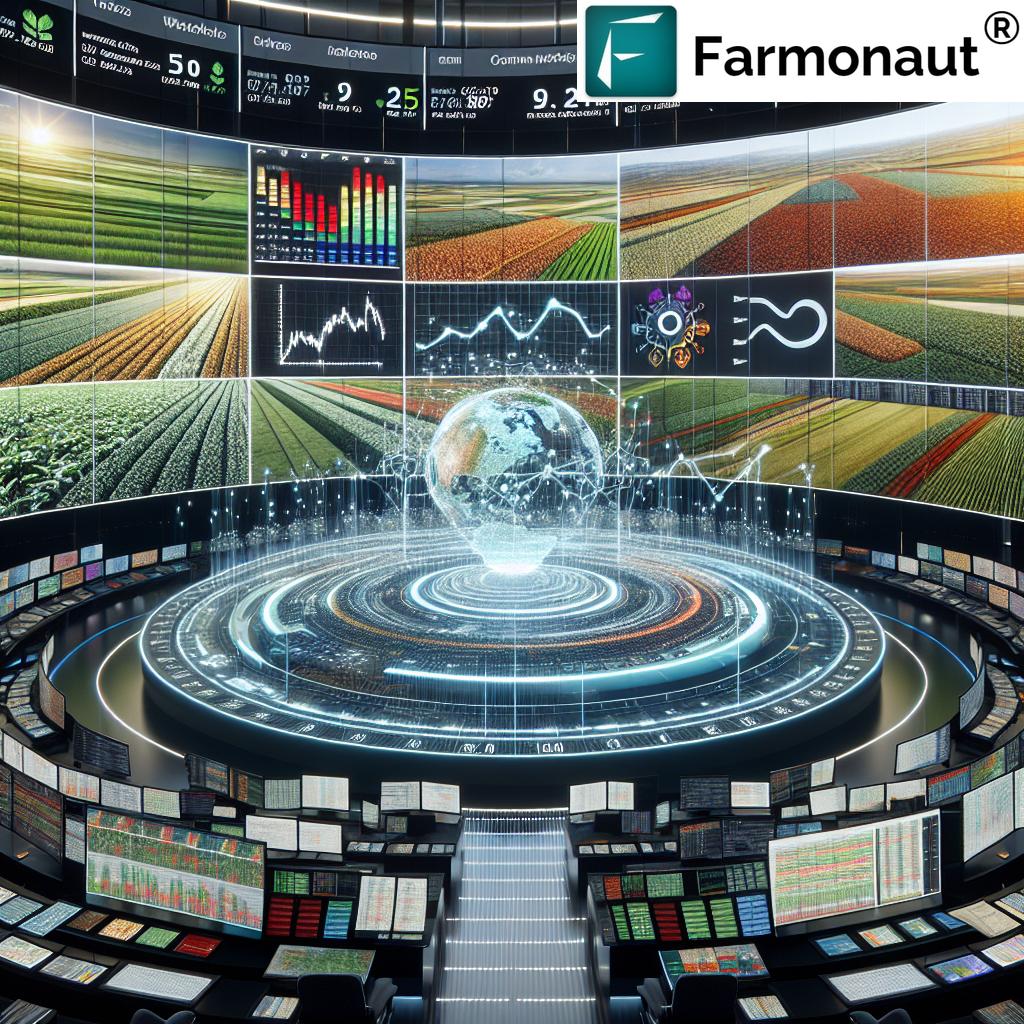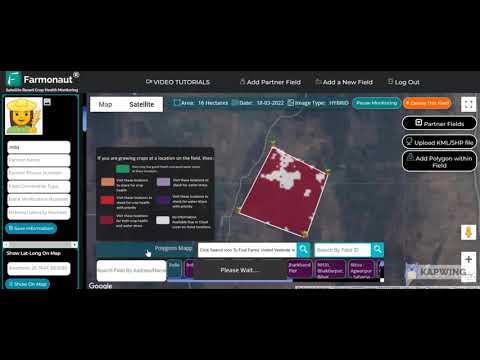Mastering Agricultural Futures: Farmonaut’s Guide to Data-Driven Risk Management Strategies

“Agricultural futures trading volume increased by 300% in the last decade, driven by precision agriculture technologies.”
In today’s rapidly evolving agricultural landscape, mastering the intricacies of futures trading and implementing robust risk management strategies has become paramount for farmers and traders alike. As we navigate the complex world of agricultural derivatives, it’s crucial to leverage cutting-edge technologies and data-driven insights to stay ahead of the curve. In this comprehensive guide, we’ll explore how futures trading in agriculture, combined with precision agriculture technologies, is revolutionizing risk management in farming.
At Farmonaut, we understand the critical role that data plays in modern agriculture. Our satellite-based farm management solutions provide invaluable insights that can be seamlessly integrated with agricultural futures trading strategies. By combining real-time crop health monitoring with market intelligence, we offer a powerful toolset for farmers and traders to make informed decisions and optimize their portfolios.
Understanding Agricultural Futures and Options
Before delving into advanced risk management strategies, it’s essential to grasp the fundamentals of agricultural futures and options trading. These financial instruments serve as the backbone of risk management in the agricultural sector, allowing farmers and traders to hedge against price volatility and secure their financial positions.
Agricultural Futures Contracts
Futures contracts are standardized agreements to buy or sell a specific quantity of an agricultural commodity at a predetermined price on a future date. These contracts are traded on commodity exchanges and provide several benefits:
- Price discovery: Futures markets help determine fair prices for agricultural commodities.
- Risk transfer: Farmers can lock in prices for their crops, while buyers can secure future supplies.
- Market liquidity: High trading volumes ensure efficient price formation and easy entry/exit.
Agricultural Options
Options contracts give the holder the right, but not the obligation, to buy (call option) or sell (put option) a specific quantity of an agricultural commodity at a predetermined price within a set timeframe. Options offer additional flexibility in risk management:
- Limited downside risk: Option buyers have limited loss potential to the premium paid.
- Leverage: Options allow traders to control larger positions with less capital.
- Customizable strategies: Various option combinations can be used to tailor risk exposure.
By understanding these fundamental tools, farmers and traders can begin to construct sophisticated risk management strategies that align with their specific needs and market outlook.
The Role of Data Analytics in Agricultural Risk Management
In the era of big data, agritech data analytics has emerged as a game-changer in agricultural risk management. By harnessing the power of satellite imagery, weather data, and artificial intelligence, farmers and traders can gain unprecedented insights into crop conditions, market trends, and potential risks.
At Farmonaut, we leverage advanced satellite technology to provide real-time crop health monitoring and AI-driven insights. Our platform enables users to:
- Track vegetation health indices (NDVI) across vast agricultural areas
- Monitor soil moisture levels and identify potential irrigation needs
- Detect early signs of pest infestations or crop diseases
- Analyze historical crop performance data for improved forecasting
By integrating these data-driven insights with futures trading strategies, farmers and traders can make more informed decisions about when to enter or exit positions, how to adjust their hedging strategies, and which risk management tools to employ.
Precision Agriculture Technologies and Risk Mitigation
Precision agriculture technologies are revolutionizing the way farmers approach risk management. By optimizing resource usage and improving crop yields, these advanced tools help minimize production risks and enhance overall farm profitability.
Some key precision agriculture technologies that complement futures trading strategies include:
- Variable rate technology (VRT) for optimized input application
- GPS-guided machinery for improved planting and harvesting efficiency
- Drone-based imaging for high-resolution crop monitoring
- IoT sensors for real-time field condition monitoring
Farmonaut’s platform seamlessly integrates with these precision agriculture technologies, providing a comprehensive solution for farm management and risk assessment. By combining satellite-based crop monitoring with on-the-ground precision farming data, we offer unparalleled insights that can inform futures trading decisions and risk management strategies.
Advanced Risk Assessment Tools for Agricultural Futures
To effectively navigate the complex world of agricultural futures, traders and farmers need access to sophisticated risk assessment tools. These tools help analyze market trends, evaluate potential outcomes, and optimize trading strategies.
Some essential risk assessment tools include:
- Value at Risk (VaR) models for quantifying potential losses
- Monte Carlo simulations for scenario analysis
- Stress testing methodologies for evaluating portfolio resilience
- Correlation analysis for understanding relationships between different commodities
Farmonaut’s platform complements these financial risk assessment tools by providing real-time agricultural data that can be incorporated into risk models. Our satellite-based crop monitoring system offers valuable insights into potential yield variations, which can significantly impact futures prices and trading strategies.
Commodity Trading Strategies for Agricultural Futures
Successful trading in agricultural futures requires a well-defined strategy that takes into account market conditions, risk tolerance, and individual goals. Here are some popular commodity trading strategies used in agricultural futures markets:
- Trend Following: This strategy involves identifying and following established market trends, either upward or downward.
- Mean Reversion: Traders using this approach bet on prices returning to their historical average after periods of extreme movement.
- Spread Trading: This involves simultaneously buying and selling related futures contracts to profit from price differentials.
- Seasonal Trading: Based on historical patterns, this strategy aims to capitalize on recurring price movements tied to agricultural cycles.
- Options Strategies: Various options combinations, such as straddles or butterflies, can be used to profit from different market scenarios.
When implementing these strategies, it’s crucial to incorporate real-time market data and agricultural insights. Farmonaut’s platform provides up-to-date information on crop health and potential yield, which can be invaluable in refining trading strategies and managing risk effectively.

Leveraging Market Insights for Informed Trading Decisions
In the fast-paced world of agricultural futures, having access to timely and accurate market insights is crucial for making informed trading decisions. Traders and farmers must constantly evaluate a wide range of factors that can impact commodity prices, including:
- Global supply and demand dynamics
- Weather patterns and natural disasters
- Government policies and trade agreements
- Economic indicators and currency fluctuations
- Technological advancements in agriculture
Farmonaut’s platform contributes to this market intelligence by providing real-time data on crop health and potential yields across vast agricultural areas. By integrating this information with other market data sources, traders can gain a more comprehensive understanding of potential price movements and adjust their strategies accordingly.
Smart Farming Solutions and Their Impact on Futures Trading
Smart farming solutions are transforming agricultural practices and, by extension, influencing futures trading dynamics. These innovative technologies enable farmers to optimize their operations, reduce costs, and improve crop yields – all of which can have significant implications for commodity prices and futures markets.
Key smart farming solutions include:
- Automated irrigation systems
- AI-powered crop management platforms
- Robotic harvesting equipment
- Blockchain-based supply chain management
Farmonaut’s platform integrates seamlessly with many of these smart farming solutions, providing a comprehensive approach to farm management and risk assessment. By leveraging our satellite-based crop monitoring in conjunction with on-the-ground smart farming data, traders and farmers can gain a more accurate picture of potential yields and market trends.
Portfolio Optimization in Agricultural Futures Trading
Effective portfolio management is essential for success in agricultural futures trading. Traders must carefully balance risk and return while considering factors such as diversification, correlation between different commodities, and overall market exposure.
Key considerations for portfolio optimization include:
- Asset allocation across different agricultural commodities
- Risk-adjusted return metrics (e.g., Sharpe ratio, Sortino ratio)
- Rebalancing strategies to maintain desired risk levels
- Incorporation of non-agricultural assets for broader diversification
Farmonaut’s platform can play a crucial role in portfolio optimization by providing real-time data on crop health and potential yields. This information can help traders adjust their positions based on anticipated supply changes, potentially improving overall portfolio performance.
Managing Market Volatility in Agricultural Futures
Agricultural futures markets are known for their volatility, driven by factors such as weather events, geopolitical tensions, and shifts in global supply and demand. Successfully navigating this volatility requires a combination of robust risk management strategies and access to real-time market data.
Some effective approaches to managing market volatility include:
- Implementing stop-loss orders to limit potential losses
- Using options strategies to hedge against adverse price movements
- Diversifying across different agricultural commodities and contract months
- Regularly monitoring and adjusting positions based on changing market conditions
Farmonaut’s satellite-based crop monitoring system provides valuable insights that can help traders anticipate and respond to market volatility. By tracking crop health and potential yields in real-time, our platform enables users to make more informed decisions about when to enter or exit positions.
“Farmonaut’s satellite-based crop monitoring integrates with over 50 global commodity exchanges for real-time market intelligence.”
The Role of Historical Datasets in Refining Trading Strategies
Historical data plays a crucial role in developing and refining trading strategies for agricultural futures. By analyzing past price movements, market trends, and crop yield data, traders can identify patterns and relationships that inform their decision-making processes.
Key applications of historical datasets include:
- Backtesting trading strategies to evaluate their potential performance
- Identifying seasonal patterns in commodity prices
- Analyzing the impact of various factors (e.g., weather events, policy changes) on market dynamics
- Calibrating risk models and improving forecasting accuracy
Farmonaut’s platform provides access to historical satellite imagery and crop health data, which can be invaluable in these analyses. By combining our agricultural insights with traditional market data, traders can develop more robust and data-driven strategies.
Real-Time Market Data and Its Impact on Trading Efficiency
In the fast-paced world of agricultural futures trading, access to real-time market data is essential for maintaining a competitive edge. Timely information allows traders to react quickly to changing market conditions, identify opportunities, and manage risk more effectively.
Key types of real-time data used in agricultural futures trading include:
- Live price quotes and order book depth
- Breaking news and economic announcements
- Weather forecasts and crop condition reports
- Trading volume and open interest statistics
Farmonaut’s platform contributes to this real-time data ecosystem by providing up-to-the-minute information on crop health and potential yields. Our satellite-based monitoring system allows traders to track agricultural conditions across vast areas, potentially identifying supply changes before they’re reflected in official reports.
Integrating Farmonaut’s Platform with Futures Trading Strategies
Farmonaut’s innovative satellite-based crop monitoring system offers a powerful complement to traditional futures trading strategies. By integrating our platform’s insights with your existing trading approach, you can gain a more comprehensive understanding of agricultural markets and potential price movements.
Key benefits of integrating Farmonaut’s platform include:
- Early detection of potential supply changes due to crop health issues
- Improved accuracy in yield forecasting
- Real-time monitoring of agricultural conditions across multiple regions
- Historical data for strategy development and backtesting
To maximize the value of Farmonaut’s insights, consider the following integration strategies:
- Use our vegetation health indices (NDVI) as leading indicators for potential yield changes
- Incorporate our soil moisture data into your weather-based trading models
- Leverage our historical datasets to identify long-term trends and seasonal patterns
- Set up alerts based on our real-time crop health monitoring to inform your trading decisions
By combining Farmonaut’s agricultural intelligence with traditional market data and analysis, traders can develop more robust and data-driven strategies for navigating the complex world of agricultural futures.
Risk Assessment Tools for Agricultural Futures
Effective risk management in agricultural futures trading requires the use of sophisticated assessment tools. These tools help traders and farmers evaluate potential outcomes, quantify risk exposure, and make informed decisions about their trading strategies.
Some essential risk assessment tools for agricultural futures include:
- Value at Risk (VaR): This statistical measure estimates the potential loss in value of a portfolio over a specific time horizon.
- Stress Testing: By simulating extreme market scenarios, traders can assess how their portfolios might perform under adverse conditions.
- Sensitivity Analysis: This technique helps identify how changes in various factors (e.g., price, volatility) affect the value of a futures position.
- Monte Carlo Simulations: These complex models generate numerous potential scenarios to provide a probabilistic view of possible outcomes.
Farmonaut’s platform can enhance these risk assessment tools by providing real-time data on crop health and potential yields. By incorporating our agricultural insights into risk models, traders can gain a more accurate picture of potential market movements and adjust their strategies accordingly.
Optimizing Futures Trading with Data Analytics
Data analytics has become an indispensable tool in modern futures trading, allowing traders to process vast amounts of information and identify patterns that may not be apparent through traditional analysis methods.
Key applications of data analytics in futures trading include:
- Predictive modeling for price forecasting
- Pattern recognition in market data
- Sentiment analysis of news and social media
- Optimization of trading algorithms
Farmonaut’s platform contributes to this data-driven approach by providing valuable agricultural insights derived from satellite imagery and AI analysis. Our crop health monitoring and yield prediction capabilities can be seamlessly integrated into data analytics workflows, enhancing the accuracy and effectiveness of trading strategies.
Agricultural Futures Risk Management Comparison
| Risk Management Strategy | Potential Return (Estimated %) | Risk Level | Data Requirements | Farmonaut Integration Benefits |
|---|---|---|---|---|
| Traditional Futures Contracts | 5-15% | High | Market prices, supply/demand data | Real-time crop health monitoring for supply predictions |
| Options Trading | 10-20% | Medium | Market prices, volatility measures | Improved yield forecasting for more accurate pricing |
| Weather Derivatives | 8-12% | Medium | Historical weather data, climate models | Satellite-based soil moisture and temperature data |
| Precision Agriculture-based Hedging | 12-18% | Low | On-farm sensors, yield maps | Integration with on-ground data for comprehensive insights |
| Satellite Data-driven Decision Making | 15-25% | Low | Satellite imagery, AI analysis | Core functionality of Farmonaut’s platform |
Future Trends in Agricultural Futures and Risk Management
As technology continues to evolve and markets become increasingly interconnected, the landscape of agricultural futures trading and risk management is poised for significant changes. Some emerging trends to watch include:
- Artificial Intelligence and Machine Learning: Advanced algorithms will play an increasingly important role in market analysis and trading execution.
- Blockchain Technology: Distributed ledger systems may revolutionize contract settlement and supply chain tracking in agricultural markets.
- Climate-Resilient Agriculture: As climate change impacts become more pronounced, new financial instruments may emerge to hedge against these risks.
- Integration of Alternative Data Sources: Satellite imagery, IoT sensors, and social media sentiment will likely become standard inputs for trading models.
Farmonaut is at the forefront of these trends, continuously innovating our satellite-based crop monitoring system to provide cutting-edge insights for the agricultural futures market. By staying ahead of technological advancements, we aim to empower traders and farmers with the tools they need to navigate an increasingly complex trading environment.
Conclusion: Embracing Data-Driven Risk Management in Agricultural Futures
As we’ve explored throughout this guide, mastering agricultural futures trading requires a multifaceted approach that combines traditional financial knowledge with cutting-edge technology and data-driven insights. By leveraging advanced risk management strategies, precision agriculture technologies, and real-time market data, traders and farmers can navigate the complexities of agricultural markets with greater confidence and efficiency.
Farmonaut’s innovative platform stands at the intersection of satellite technology, artificial intelligence, and agricultural expertise, offering a powerful tool for enhancing futures trading strategies and risk management practices. By integrating our real-time crop monitoring insights with traditional market analysis, users can gain a competitive edge in the fast-paced world of agricultural derivatives.
As we look to the future, the importance of data-driven decision-making in agricultural futures trading will only continue to grow. By staying informed about emerging trends, continuously refining trading strategies, and embracing innovative technologies like Farmonaut’s platform, traders and farmers can position themselves for success in an ever-evolving market landscape.
We invite you to explore how Farmonaut’s satellite-based crop monitoring system can enhance your approach to agricultural futures trading and risk management. Together, we can build a more resilient, efficient, and profitable agricultural sector for the future.
FAQ Section
- Q: How does Farmonaut’s platform enhance agricultural futures trading?
A: Farmonaut provides real-time satellite-based crop health monitoring and yield predictions, which can be integrated into trading strategies to improve decision-making and risk management. - Q: Can Farmonaut’s data be used for both short-term and long-term trading strategies?
A: Yes, our platform offers real-time insights for short-term trading decisions, as well as historical data and trend analysis for developing long-term strategies. - Q: How often is Farmonaut’s satellite data updated?
A: Our satellite data is updated frequently, with most areas covered every few days, ensuring users have access to the most current agricultural insights. - Q: Is Farmonaut’s platform suitable for individual traders or just large institutions?
A: Farmonaut’s platform is designed to be accessible and valuable for a wide range of users, from individual traders and farmers to large financial institutions and agribusinesses. - Q: How can I integrate Farmonaut’s data into my existing trading models?
A: Farmonaut offers API access and comprehensive documentation to facilitate easy integration of our agricultural insights into existing trading systems and models.






